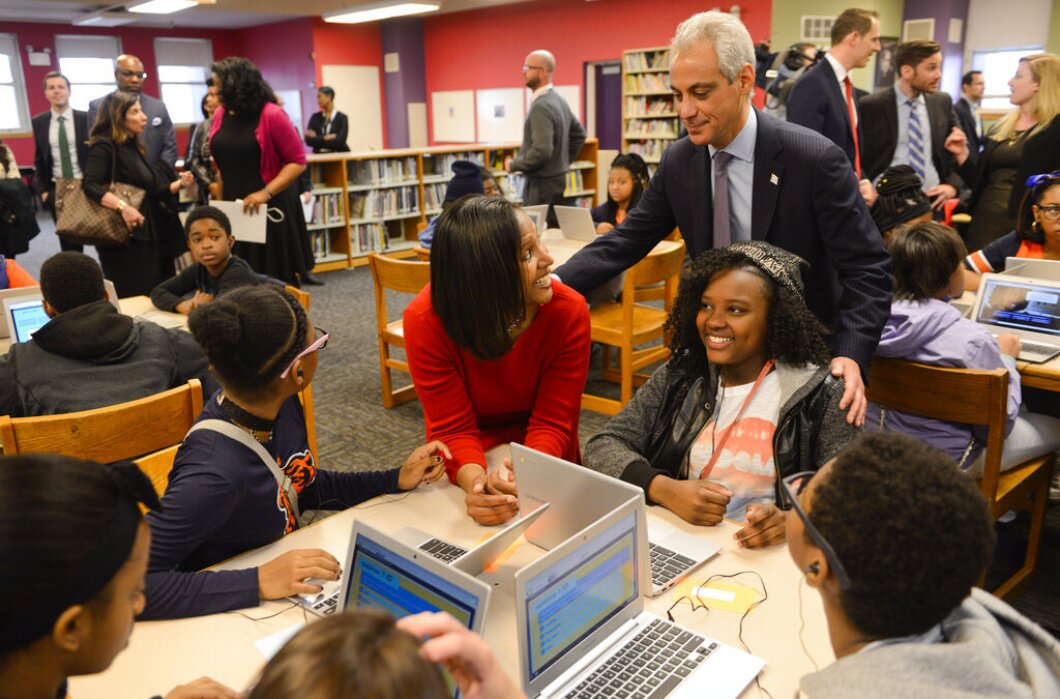
Chicago made headlines in 2013 for the largest mass school closing in the nation’s history. Ten years later, Mayor Brandon Johnson, who offered promises of staunch education reform, will now have to work collaboratively with the city’s school system to develop what remains of the closed schools.
Johnson, a Democrat who made education reform a key component of his mayoral campaign, will be faced with potentially repurposing over 20 vacant school buildings that were part of the school closure in 2013.
SCHUMER PROJECTS DEBT CEILING OPTIMISM AS PROGRESSIVES FRET ABOUT DEAL
Then-Democratic Mayor Rahm Emanuel and his administration knew the schools were run down and in need of repairs, but he determined that the cost to fix the 46 buildings, which housed 50 schools on the city’s South and West sides, was too expensive and that it did not make sense to restore schools.
Emanuel promised that all of the buildings would be repurposed. However, only 43% of the buildings, or 20 buildings, are back in use, according to an analysis from the Chicago Sun-Times and WBEZ.

Seven have been revamped by government bodies, including offices for the Chicago Public Schools. One building currently serves as a temporary shelter for immigrants. Thirteen were bought by private groups or luxury housing complexes. The remaining six are a union hall, a community center, fraternity headquarters, a daycare center, senior citizen and veterans apartments, and a field house for the Chicago Park District.
Despite all of the newly added services these repurposed buildings have provided over the years, 57% of the buildings still remain vacant.
Chicago Public Schools spokeswoman Mary Fergus told the outlets that the sale process was put on hold in 2019 by Lori Lightfoot’s administration, with the recently departed mayor hoping to develop a strategy on “potential repurposing or redevelopment of these sites.”
Before leaving office, however, Lightfoot allocated $12 million for a project to transform the former Emmet Elementary in Austin into the Aspire Center, a $41 million workforce development center.
Pedro Martinez, CEO of Chicago Public Schools, told the Chicago Sun-Times that the pandemic was partly to blame for redevelopment delays.
“We’re having those conversations now. I am actually also looking forward to Mayor [Brandon] Johnson and really having a stronger conversation with him as well as the city around how we can better plan around these facilities,” Martinez said.
Of the buildings that remain vacant, 26 have not been returned to use. Of the 26, 16 are publicly owned and vacant. The other 10 buildings were sold but are not in use.
The amount of money to renovate and restore these buildings is something Chicago Public School officials say they cannot calculate. The school system pays to secure and maintain the empty buildings, and while it costs less now than it did when operating a fully staffed and operational school, the cost to clean up the grounds and replace materials cuts into the projected savings needed for redevelopment.
However, an unexpected surplus in funds may be the golden ticket for the vacant schools. Johnson inherited an $85 million budget gap for his first year as mayor, a surprising figure compared to Lightfoot’s inherited budget gap of $838 million from Emanuel in 2019.
Chicago has been suffering from a major decline in education rates since the pandemic. As of Feb. 3, the school system has lost over 36,000 students, and 20% fewer students are proficient in reading and math since 2019.
Education served as a major focal point for the 2023 mayoral race in Chicago, as both runoff candidates had ties to the system: Paul Vallas served as the former CEO of Chicago Public Schools, and Johnson was a teacher before becoming a Cook County commissioner.
Johnson drew on his past experiences working for the now-closed Jenner Academy of the Arts and his interactions with students on the campaign trail.
“One of my students looked me in the face and said, ‘Mr. Johnson, you should not be teaching here. … You should be teaching at a good school,’” Johnson said during his victory speech at the general election. “It broke my heart then. It breaks my heart today. I wanted to change the system.”
While Vallas approached education with a fiscal perspective, Johnson appealed to voters on promises of comprehensive reform with needs-based funding to schools and free transportation for homeless students.
CLICK HERE TO READ MORE FROM THE WASHINGTON EXAMINER
He also said he planned to increase funding to expand staffing and increase clinicians and counselors, as well as expand partnerships with city colleges and trade schools. Teachers overwhelmingly backed Johnson in the general and runoff elections, with the Chicago Teachers Union donating $3.2 million to his campaign.
The Washington Examiner reached out to Johnson and Chicago Public Schools for comment.





